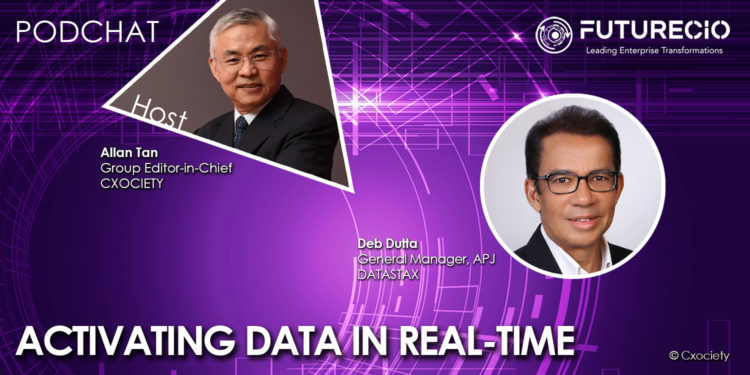
“Data has become the most important asset of any organisation and data and analytics are more critical than ever. New use cases for data to support machine learning, artificial intelligence and analytics are endless. As the rate of change continues, embracing flexibility, agility and adapting to new challenges is a must,” said Donald Feinberg, distinguished VP analyst, Gartner.
Some say that enterprises today are now able to capture and store just about every type of and format of data. What remains a challenge, however, is activating this data. Why is that? Name key technical, operational and process issues that are hindering this activation of data.
According to Deb Dutta, general manager for Asia Pacific & Japan at DataStax, data is an asset that needs to be mined. “It needs to be a line item in people's balance sheets,” he opined.
However, he acknowledged that data, while pervasive across the organisation, it exists in silos.
“Try to visualize it this way. There's a new application that is built and that application has an API, and the API is connected to them, your application is talking to a set of data, and then you build another application. And that application has another set of APIs connected to another set of data, and so forth,” he elaborated.
He went on to add that this condition of multiple silos of applications connected to their own data sets exists across many vertical industries. Worst of all, the data sets do not talk to one another.

“You have captured a lot of information, but you are not able to visualize the business in a 360-degree view, because these pieces of information are lying in these multiple boxes. What the world is looking at now is to create an operational data store that can connect all these pieces of information."
Deb Dutta
Dutta posited that whether internally and externally, the organisation has got overall access to all pieces of data that they have created over any period – past, present, and future. For him, this is the basic challenge that organisations face today.
How do you align data and analytics with business outcomes and digital acceleration?
Deb Dutta: There are two value propositions of real-time data. One is internal agility, you make your business agile internally, from within. And the second thing, which is becoming very important, if not more important than internal agility is, what kind of customer experience you want to provide to your external stakeholders.
These two pieces of information, help you with your internal business agility. That is what real-time data fills, regardless of what industry segment you happen to be in.
How do you foster cultural changes needed to make the use of data and analytics pervasive to impact the business?
Deb Dutta: I think it must be a top-down process, right from the CEO downwards. That said, you can't build a data-driven enterprise just because the CEO says so. Across the board and in every functional group within the organisation everyone needs to understand the value proposition, the value and the why behind this transformation.
And only then does it happen.
Constellation Research principal analyst Dion Hinchcliffe writes that the future belongs to simple, simplified real-time cloud-native data at scale. What needs to happen for enterprises to come closer to this future?
Deb Dutta: Companies like Gojek, Tokopedia Grab, and Flipkart are born in the cloud, and have a cloud-first strategy. They are built for scale. They are built for big throughput, low, less latency, and very quick response time. They know that they need to be there already in the transformation environment because they don't know what legacy is.
These guys are setting the bar very high. Now, the legacy enterprise feels threatened. They know that if they need to move the needle, the fastest and the most efficient way to move the needle is by using disruptive technology.
And one of the best forms of this technology other than the utilisation of the cloud is the utilisation of data. This is the second thing that is driving this transformation
The third driver of transformation is government. The Government sector has a very large agenda around digital transformation just to stay relevant and they are doing digital transformation at scale through citizen services.
For an organisation wanting to become real-time data, what do they need to do?
Deb Dutta: The first step is to start building that operational data store common layer of data that extracts data from all the application silos – the data silos that support your application.
By creating an operational data store on the top, you are liberating the data that is locked up in the silos.
But just data on an operational data store is also not good enough. We should be able to capture changes in that operational data store. Changes in that operational data store cannot be done through a batch process, it needs to be done through a real-time process.
Then you need a technology that can take that operational data store information and any changes on that data and transfer it to these downstream systems.
Click on the PodChat player and listen to Dutta share his perspective on how organisations in Asia can activate their data in real-time.
- Some say that enterprises are now able to capture and store just about every type and format of data. What remains a challenge is activating this data. Why is that? Can you cite key technical, operational and processes that are hindering this activation of data?
- How do you align data and analytics with business outcomes and digital acceleration?
- How do you foster cultural changes needed to make the use of data and analytics pervasive to impact the business?
- Constellation Research principal analyst Dion Hinchcliffe writes that the future belongs to simple, simplified real-time cloud-native data at scale. What needs to happen for enterprises to come closer to this future?
- For an organisation wanting to become real-time data, what do they need to do?





